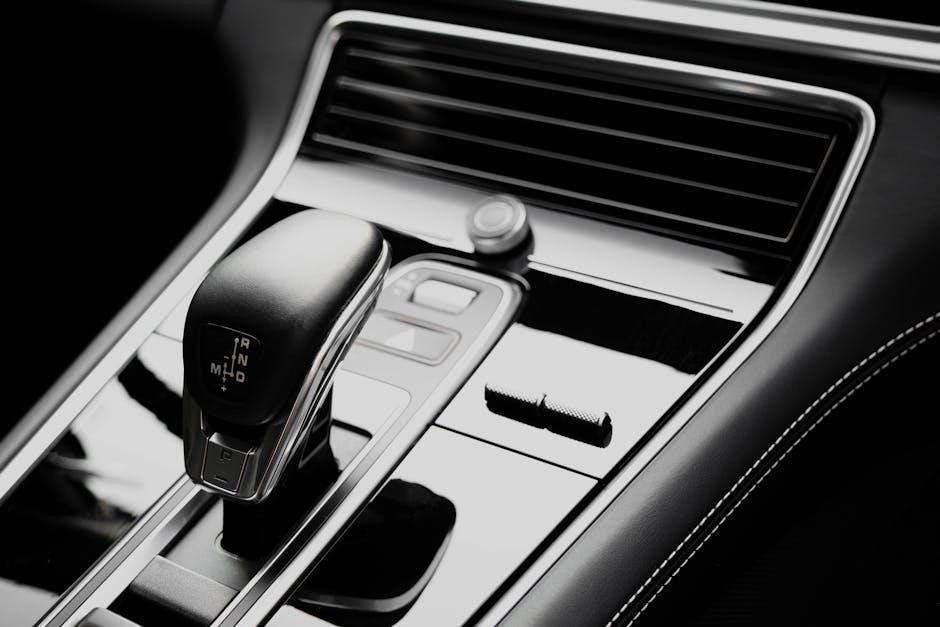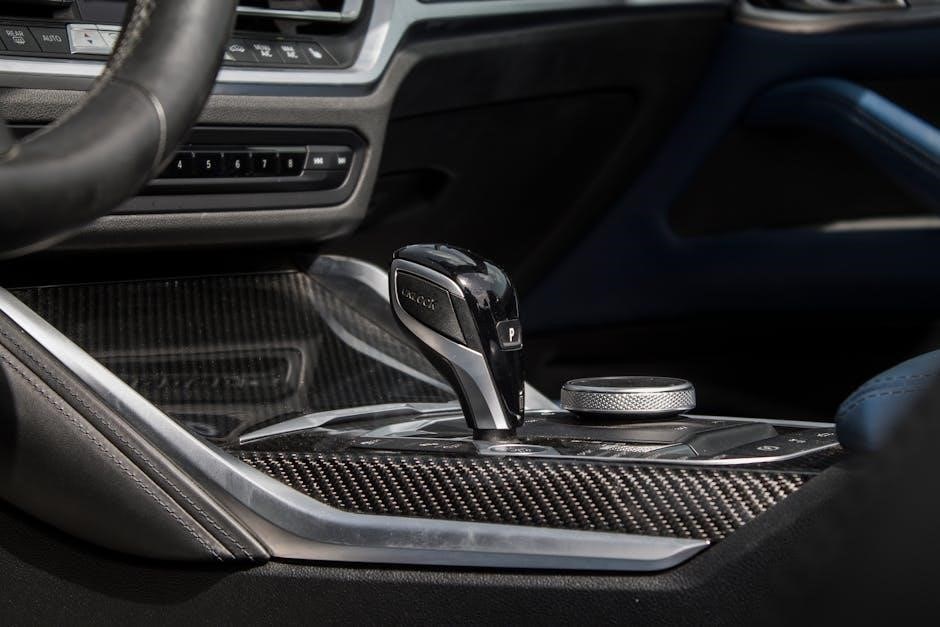Converting a manual transmission to automatic involves complex processes, requiring specialized tools and professional expertise. This guide explores the feasibility, costs, and technical aspects to help you decide if it’s worth the investment.
Understanding the challenges and benefits is crucial before starting your project. Learn how to approach the conversion, including essential components and compatibility considerations, to ensure a smooth transition to automatic driving.
Why Convert to Automatic Transmission?
Converting to an automatic transmission offers enhanced convenience, reducing driver fatigue in heavy traffic and hilly terrains. It provides smoother acceleration and easier handling, making it ideal for urban driving. Automatic transmissions also cater to individuals with mobility challenges, eliminating the need for manual clutch operation. Additionally, modern automatic systems often deliver improved fuel efficiency and performance, making them a practical choice for everyday use. This conversion is particularly beneficial for those seeking a more relaxed and stress-free driving experience.

Understanding the Technical Requirements
Converting manual to automatic involves complex mechanical and electrical adjustments, requiring specialized tools and expertise. Key components include transmission controllers, torque converters, and wiring harnesses, with compatibility varying by vehicle, necessitating custom solutions.
Essential Components for Conversion
The process requires a transmission controller, torque converter, and valve body to regulate gear shifts. A compatible wiring harness and clutch system must also be installed. Additionally, the engine’s computer (ECU) may need reprogramming to support automatic functions. Each component must be carefully selected to ensure compatibility with the vehicle’s make and model. Professional installation is often necessary to avoid mechanical failures and ensure optimal performance. These parts work together to enable smooth, automatic gear transitions.
Compatibility and Vehicle-Specific Considerations
Ensuring compatibility is critical when converting a manual to an automatic transmission. The vehicle’s make, model, and year dictate the suitability of conversion kits and components. Factors such as engine type, axle ratio, and existing drivetrain must align with the automatic system. Some vehicles may require modifications to the chassis or wiring harness, while others might need additional hardware like a torque converter. Compatibility checks prevent mechanical issues and ensure seamless integration of the new transmission system.

Cost Estimation and Financial Considerations
Converting a manual to automatic transmission costs between $1,000 and $3,000 or more, depending on the vehicle and complexity. Parts, labor, and compatibility requirements influence the total expense.
Breakdown of Conversion Costs
The cost to convert a manual to automatic transmission typically ranges from $1,000 to $3,000 or more. Key expenses include the transmission kit, labor, and additional components like the torque converter, transmission controller, and wiring harness. Professional installation can add significant labor costs, while DIY projects may save money but require specialized tools. Factors like vehicle make, model, and year influence pricing, with some modifications requiring extra parts like axle regearing or overdrive units. Always consult a professional for an accurate estimate tailored to your vehicle.
Alternative Options: Buying an Automatic Vehicle

Converting a manual to automatic transmission involves significant expenses. The cost typically ranges from $1,000 to $3,000 or more, depending on the vehicle and complexity; Key components include the automatic transmission kit, torque converter, transmission controller, and wiring harness. Labor costs for professional installation can add up quickly, while DIY projects may reduce expenses but require specialized tools and expertise. Additional fees might include axle regearing or overdrive units, depending on the vehicle’s specifications. Always obtain a detailed estimate from a professional to understand the full financial commitment.

Pros and Cons of Manual to Automatic Conversion

Advantages of Automatic Transmission
Automatic transmissions offer convenience, reduced driver fatigue, and smoother operation in heavy traffic, making them ideal for urban driving and those seeking effortless gear shifting.
Disadvantages and Potential Drawbacks
Conversion costs are high, and fuel efficiency may decrease. The process is complex, requiring specialized tools and expertise, making it less practical for some vehicle owners.
Automatic transmissions offer unparalleled convenience, reducing driver fatigue in heavy traffic and providing smoother acceleration. They are ideal for urban driving, eliminating the need for constant clutch engagement. This makes them accessible to a broader audience, including those with mobility challenges. Modern automatics also often feature advanced fuel-saving technologies, balancing efficiency with performance. The ease of operation and reduced complexity for drivers make automatic transmissions a desirable upgrade for many vehicle owners.
Converting a manual to an automatic transmission can be costly and complex, often requiring additional modifications to the engine, wiring, and ECU. The process may void warranties and reduce fuel efficiency in some cases. Maintenance costs for automatic transmissions are typically higher than for manuals. Additionally, the conversion process can be time-consuming and may not always guarantee optimal performance, depending on the vehicle’s make and model. These factors make it essential to weigh the benefits against the potential downsides before proceeding with the conversion.

Step-by-Step Guide to the Conversion Process
Converting a manual to automatic involves selecting the right kit, removing the manual gearbox, installing the automatic transmission, and integrating necessary components like the ECU and wiring harness.
Preparing Your Vehicle for Conversion
Before converting, assess your vehicle’s compatibility with an automatic transmission. Gather necessary tools, including a transmission kit, wiring harness, and ECU. Ensure your workspace is clean and well-equipped. Disconnect the battery and drain fluids to avoid complications. Remove the manual gearbox and associated components carefully. Inspect and prepare the engine compartment for new parts. Secure the vehicle on jack stands for safe access. Research specific instructions for your vehicle’s make and model to ensure a smooth process. Proper preparation is key to a successful conversion.
Installing the Automatic Transmission System
Begin by aligning the automatic transmission with the engine, ensuring proper connection points. Secure it firmly using bolts and brackets. Connect the torque converter to the engine, ensuring it engages smoothly. Install the transmission mounts and crossmember for stability. Reconnect the driveshaft and wiring harness, integrating the transmission controller. Ensure all fluid lines are securely attached and bled to prevent airlocks. Test the system by starting the engine and cycling through gears to verify proper operation. This step requires precision to avoid mechanical failure.

Common Challenges and Solutions
High costs, complex installation, and potential maintenance issues arise during manual-to-automatic conversions. Professional expertise and high-quality components are essential to overcome these challenges successfully.
Overcoming Technical Difficulties
Technical difficulties in manual-to-automatic conversions often stem from compatibility issues and complex wiring. Ensuring the correct transmission kit and professional installation are vital. Additionally, modifying the ECU and engine harness can resolve system integration problems. Proper alignment of the torque converter and gearbox is also critical to maintain smooth power delivery; Addressing these challenges requires precise planning and skilled labor to achieve optimal performance and reliability in the converted vehicle.
Addressing Maintenance and Performance Issues
Post-conversion, regular servicing of the automatic transmission and torque converter is essential to maintain performance. Ensuring proper fluid levels and filter condition prevents overheating and wear. Additionally, addressing any software calibration issues in the ECU is critical for smooth gear shifts. Routine checks on the drivetrain and suspension alignment can also prevent long-term damage. Proper installation and compatibility of components are key to avoiding maintenance and performance setbacks, ensuring a reliable and efficient driving experience.

Case Studies and Real-World Examples
Real-world examples highlight successful manual-to-automatic conversions, such as a Ford Mustang achieving smoother city driving and a Toyota Corolla reducing maintenance costs significantly post-conversion.
Successful Conversion Stories
A Ford Mustang owner successfully converted their manual transmission to automatic, achieving smoother city driving and reduced clutch wear. Similarly, a Toyota Corolla owner transitioned to an automatic system, lowering maintenance costs and enhancing overall comfort.
These real-world examples demonstrate the practical benefits of manual-to-automatic conversions, offering improved convenience and reduced mechanical stress on the vehicle, making daily driving more enjoyable and hassle-free.
Lessons Learned from DIY Projects
DIY enthusiasts often face unexpected challenges when converting manual to automatic transmissions. Proper planning, precise tools, and technical knowledge are essential. Many report that while cost-effective, the process is time-consuming and requires professional guidance for optimum results.
Success stories highlight the importance of researching compatible components and adhering to manufacturer instructions, ensuring a seamless and efficient conversion experience for those willing to take on the task independently.

Converting a manual to automatic transmission is a complex process requiring professional expertise. Weighing the costs and benefits, it’s often more practical to purchase an automatic vehicle outright.
Is the Conversion Worth It?
Deciding if converting a manual to automatic is worthwhile depends on your needs and budget. While it offers convenience and reduced maintenance, the high cost and complexity often make buying an automatic vehicle a more practical choice. Professional expertise is essential for a smooth conversion, but weigh the expenses against the benefits to determine the best option for your driving preferences and financial situation.
Future of Transmission Technology
Advancements in transmission technology are revolutionizing the automotive industry. Automated manual transmissions and hybrid systems are gaining popularity, offering a blend of efficiency and ease. Electric vehicles are also influencing the shift away from traditional manuals and automatics. As innovation progresses, expect smarter, more efficient, and seamless transmission options, potentially making manual-to-automatic conversions less relevant in the future.